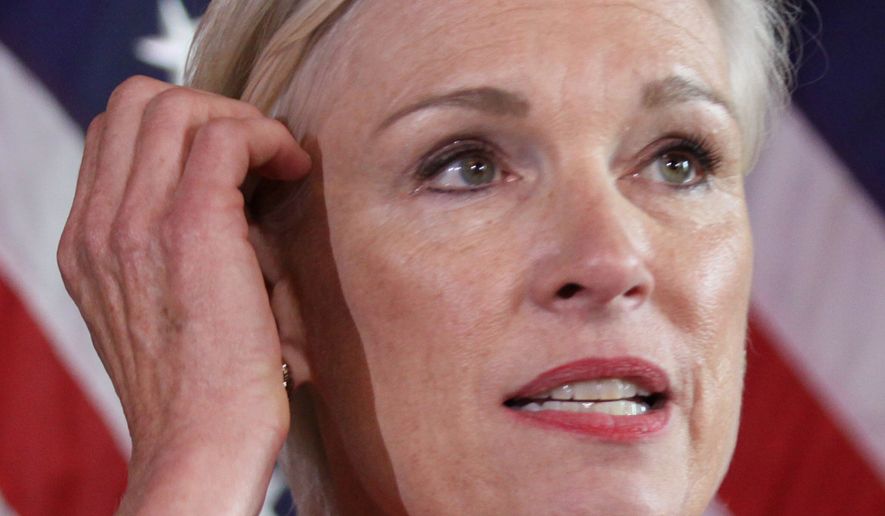Planned Parenthood’s long-held insistence that abortion constitutes only 3 percent of the organization’s services is increasingly coming under scrutiny from critics who say they don’t buy it.
Even before the recent release of two devastating undercover videos with Planned Parenthood doctors, pro-life groups like Americans United for Life (AUL) have argued that the group is downplaying its abortion percentages with an expansive definition of the term “services.”
What’s more, figures from Planned Parenthood’s annual reports dating back to 2004 show that the percentage of abortions performed is rising while other services, such as cancer screenings, are dropping, said Anna Paprocki, staff counsel for Americans United for Life.
“While Planned Parenthood continues to claim abortion as only 3 percent of its services, Planned Parenthood’s abortion business is demonstrably growing disproportionately to Planned Parenthood overall,” Ms. Paprocki said. “In fact, its overall patients — and noncontroversial services like cancer screenings and prenatal services — have been declining.”
The intensified focus on Planned Parenthood comes in the wake of the videos and the ensuing response from federal and state lawmakers. On Monday, House Majority Leader Kevin McCarthy added his name to those calling for Congress to freeze the roughly half-billion-dollars in annual federal funding to Planned Parenthood while House committees investigate.
“I think the very minimum that should happen is money should be withheld this year, until we get to the bottom of what is going on here,” Mr. McCarthy said.
Planned Parenthood Federation of America President Cecile Richards countered her critics Sunday by blasting the “militant” Center for Medical Progress, the pro-life group behind the videos, while emphasizing PPFA’s role as a provider of a wide variety of health care services.
“At Planned Parenthood, we serve two and a half million people every single year. Women come to us for the vast majority of care,” said Ms. Richards on ABC’s “This Week.” “They come to us for breast cancer screenings, cervical cancer screenings, birth control. One in five women in the country have been to Planned Parenthood for health care.”
She added, “I think one other thing is really important to understand. We do more at Planned Parenthood every single day to prevent unintended pregnancy than any organization in the country. We have for 99 years.”
In its latest annual report from 2013-14, PPFA says testing and treating sexually transmitted diseases accounts for 42 percent of its services, followed by contraception at 34 percent. “Abortion services” account for just 3 percent.
That 3 percent figure depends largely on how Planned Parenthood defines “services.” For instance, providing a pack of birth control pills or taking a patient’s blood pressure would also qualify as a “service.”
“Something like a pregnancy test is given equal weight to an abortion,” said Ms. Paprocki. “Are all these services of equal weight? When Planned Parenthood says [abortion] is 3 percent of its services, that really doesn’t tell us what it means to its bottom line, what it means in terms of staff time.”
She said a better indication of the role of abortion at Planned Parenthood affiliate clinics lies with the number of patient visits. In 2013-14, there were 2.7 million patient visits and 327,653 abortions, which would indicate that 12.1 percent of its patients were there for abortions.
“What this shows is that Planned Parenthood recognizes that the American public is uncomfortable with abortion. So they’re always trying to paint this as, ’Oh, it’s a really small part,’” said Ms. Paprocki.
Ms. Richards described abortion as “a very small part of what we do” in a 2011 interview. Foes of abortion have pushed back on that claim over the years; for example, former Sen. Jon Kyl, Arizona Republican, said in 2011 that abortion accounts for “well over 90 percent of what Planned Parenthood does.”
The watchdog group FactCheck.org called Mr. Kyl’s statement “wildly incorrect,” but also challenged Planned Parenthood’s 3 percent figure by breaking down the number of abortions per patient visit to Planned Parenthood clinics.
“Its 2011 fact sheet says it performed 332,278 abortion procedures in 2009,” said the FactCheck analysis. “That would mean that roughly one out of every 10 clients received an abortion.”
That percentage is climbing. In 2004 8.7 percent of patients received an abortion, while the latest figure is 12.1 percent, even as the percentage of abortions provided by Planned Parenthood remained at 3 percent, said Ms. Paprocki.
In a January report, AUL found that the number of breast exams and cancer screenings and prevention has decreased both as a percentage of other services and in absolute numbers since 2006, Ms. Richards’ first year as president.
The number of patient visits to Planned Parenthood has also declined from 3.1 million in 2006 to 2.7 million in 2013, according to the AUL report “Abortion, Inc.”
“Meanwhile, Planned Parenthood’s abortion business grew from 289,750 abortions in 2006, to over 327,000 abortions for each of the last five years,” said the report.
In that same period, both the absolute number of abortions performed in the U.S. and the abortion rate have steadily declined.
Planned Parenthood supporters have argued that its clinics often serve areas without access to other abortion providers. At the same time, the advent of Obamacare has provided more options to low-income patients on services such as cancer screenings and birth control.
With more undercover videos on the way, however, expect an uptick in calls for Planned Parenthood to provide more information on how it calculates its abortion percentage, such as by providing more information on total staff time and revenue involved.
“We’re getting a lot of spin,” said Ms. Paprocki. “There should be a breakdown of how much money they are charging for abortions and taking in each year for abortions, but we’re not getting that. That’s not something Planned Parenthood is disclosing.”
• Tom Howell Jr. contributed to this report.
• Valerie Richardson can be reached at vrichardson@washingtontimes.com.




Please read our comment policy before commenting.